#those are your neighbors not Russian sleeper agents
Explore tagged Tumblr posts
Text
Chat how to block all police procedural and true crime from my mom’s television
#bees speak#girl help it’s making her insane#girl if u go outside I promise u r not gonna get jumped#you are a white woman in the suburbs please calm down#those are your neighbors not Russian sleeper agents
0 notes
Text
Little Devils: 50 Years of Killer Kid Movies
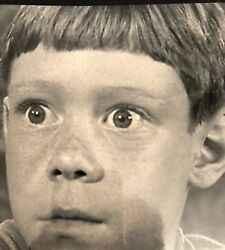
Face it, children are just plain creepy—especially the really cute ones.
Historically—and I’m talking about going back thousands of years—we’ve always been scared to death of the children we’ve spawned. Before they’re born we worry they might be physically deformed or just a little off in the head somehow. And after they’re born and as they start to grow and think and talk, hoo boy, that’s when things really start getting scary, as you start to glean a little something about what’s going on behind those cold, staring eyes. I’m not a parent myself, but having been a kid once I fully understand the panic and fear that can grip parents as they come to better understand their kids. What if they’re no good at sports? What if they start hanging out with a bad crowd and using drugs? What if they get bullied by the other kids and take revenge by shooting up the school? Worse still, what if they decide to bludgeon us to death with a crowbar in our sleep one night? What if they turn out to be the bona fide offspring of Satan himself? What the hell do we do then? Sure, we all pretend to be shocked and dismayed when we hear news stories about some eight-year-old in Kansas or Oregon stabbing the little neighbor girl twenty times for no apparent reason, but let’s be honest—we all know what these pint-sized miscreants are capable of doing, and have simply come to expect it.
As with a few of those other fundamental adult fears, like asteroids, nuclear war, clowns and deadly plagues, over the years our fear of children has led to its own unheralded cinematic subgenre of Killer Kid movies.
While countless slasher films from Halloween onwards feature tykes with butcher knives who grow up to become adults with butcher knives, I’m focusing here on those films in which the snot-nosed killers remain snot-nosed throughout. While I could have included those rambunctious hobo youths from William Wellman’s Wild Boys of the Road (1933), those little back-to-nature wastrels from Lord of the Flies (1963) and the matricidal zombie girl with the trowel from George Romero’s Night of the Living Dead (1968), I, um, didn’t. So sue me.
Here’s a quick chronological list of a double handful of notable features about murderous children. It’s interesting to note that as the years pass, the films themselves seem to grow less clever, endearing, original and interesting. Just like kids!
The Bad Seed (1956)
I’ve long been a big fan of that Mervyn LeRoy. As a director, he always understood the darker side of human nature, and had a sly sense of humor about it. In 1931 he directed my two favorite (and two of the bleakest) Edward G. Robinson pictures, Five-Star Final and Two Seconds. Then eight years later he directed The Wizard of Oz. I always like to think (though I’m undoubtedly wrong about this) he intended his 1956 creeper The Bad Seed as a kind of bonk on the head to those audience members who hadn’t recognized the darkness that lay at the heart of The Wizard of Oz.
Okay, Nancy Kelly plays Christine, the nightmare-plagued mother of the world’s most perfect little girl. Not only is blonde, pigtailed and always immaculately dressed Rhoda (Patty McCormack) perfect, the ten-year old knows she’s perfect. As a perfect child, she also knows what she deserves out of life and those around her, and lord help anyone who doesn’t cough it up. As time goes on, Christine begins to suspect Rhoda may somehow be responsible for the tragic drowning of a classmate who’d recently won an award Rhoda felt she rightly deserved. And if she was responsible for that, maybe she was responsible for all those other weird deaths that have been happening all over town, too. And what the hell’s the deal with that recurring nightmare, anyway?
Although based on a stage play that was itself based on a novel, it was LeRoy’s film that would become the standard reference point and template for so many of the Killer Kid movies down the line, though few would come close to matching it.
Village of the Damned 1960
John Wyndham was a reasonably popular pulp writer in the 1930s. While his crime stories gained him the most attention at the time, these days he’s best remembered for his occasional forays into sci-fi and horror. Day of the Triffids, his end-of-the-world masterpiece about killer plants (a personal phobia) was a major hit when adapted for the big screen, but his cautionary evil kid tale Village of the Damned had a much longer reach after director Wolf Rilla got ahold of it.
Yes, we all know the story: one day everyone living in a small English village falls asleep at the same time for some unknown reason. When they awaken several hours later, all the women of child-bearing age (even the virgins!) find they’re pregnant. Weirder still, they all go into labor at exactly the same time.
Ten years later, all the kids born that day have turned out to be extremely intelligent, blond, beautiful, and emotionless. Snappy dressers though they may be, they’re also arrogant little snots who have no time for adults or other kids, and only hang out with one another all the time. They also seem to share a psychic connection, and there are hints they have some larger purpose in mind. Anyone who tries to interfere with them gets the creepy glowing eyes treatment shortly before unexpectedly committing suicide. George Sanders at the top of his game plays a rational sort who tries to get to the Bottom of what all the hell,
It remains a starkly eerie and atmospheric picture that to this day can still make you want to punch blond British pre-teens right in the face.
The film went on to spawn one lesser sequel (1964’s Children of the Damned), one superior sort-of sequel (Joseph Losey’s 1962 These Are the Damned), a 1995 remake directed by Jon Carpenter, and a Simpsons parody. My favorite bit of cultural impact, however, is that some of your more out-there paranoids have worked Village of the Damned into the Montauk Project conspiracy, claiming beautiful, blond alien/human hybrids were created in the secret government labs in the caves beneath Montauk, Long Island. These Montauk Children, as they’re called, were set out into the world as sleeper agents (though most settled in Denver for some reason), and to this day are awaiting their secret orders from above.
The Twilight Zone: “It’s a Good Life” (1961)
It was included as one of the segments in Twilight Zone: The Movie, but good as that was, there’s just no topping the original. And there’s no topping the original because back in the early Sixties Billy Mumy was the creepiest kid on the planet. Rod Serling clearly recognized this, which is why he kept casting him.
Little Anthony Freemont (Mumy) lives in a pleasant small town where everyone knows him and everyone’s really nice to him. I mean really, really, REALLY nice to him,. And they’re really nice because over time they’ve come to realize that even if he doesn’t opt to simply blink them out of existence if they don’t do what he says, he has the power to make incredibly awful things happen to them. Even thinking bad things about Anthony isn’t such a hot idea. Things aren’t any better in the Freemont household, where his terrified parents (John Larch and Cloris Leachman) have to walk on eggshells out of fear he might do something else to his siblings, or them. )“It’s a…very GOOD thing that you did that…”)
It remains one of the most delightfully wicked and true portraits of just how terrified adults are of kids, and just how sinister kids can be.
Interestingly, Mumy apparently also had this power in real life, later going on to have a big hit with the novelty song, “Fish Heads.”
The Other (1972)
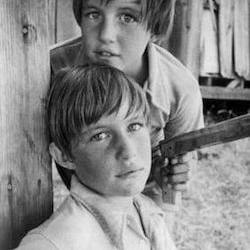
Kids alone are creepy enough, but you get twins to boot, you know you’re in for some bad news. And you get twin boys in a rural town in the 1930s? Holy mackerel, you might as well just pack it in right there and go home. Nothing good is going to come of it.
I don’t know how many times I watched Robert Mulligan’s film (based on the Thomas Tryon novel) on TV in the early Seventies, but it was a lot. Enough that to this day I still remember every shot and every line of dialog., but it still gets under my skin as one of the most effective of the lot.
Real twins Martin and Chris Udvarnoky play Holland and Niles Perry. As with most twins, one is mostly nice and sweet and innocent, while the other, Holland in this case, is the dominant, wickedly mischievous one.. Also like most twins, Niles and Holland share a weird psychic link. But in their case, and under the guidance of their Russian grandmother Eda (Uta Hagen), they can use a special ring to take things one step further. They call it The Game. As in Being John Malkovich, they can actually enter the consciousness of anyone they choose, from a magician in a traveling carnival, to a passing crow, to a corpse.
It’s a Northern Gothic tale complete with dark family secrets, farm accidents, dead babies, emotionally shattered mothers and real freaks. And an evil twin. It unfolds very slowly and quietly, and even though we get the Big Revelation at the halfway point, it doesn’t matter because the story rolls on with a few more twists and surprises left. It’s not shocking or terribly bloody, but extremely unnerving. Featuring an early turn by John Ritter and a Jerry Goldsmith score.
Don’t Look Now (1973)
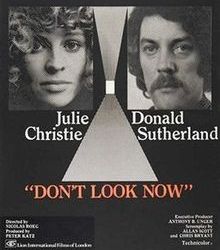
Nicholas Roeg’s brilliantly shattered, hallucinatory narrative with the shock ending might be a loose fit here, but it had such an influence on other sort of Killer Kid movies (like David Cronenberg’s The Brood) it deserves mention.
The great Donald Sutherland was rarely better than he was here as John, an architect whose young daughter recently drowned near the family home in England. He takes a job in Venice, thinking a few months away from home might be just the thing to help him and his wife cope. Shortly after they arrive, however, they encounter a blind psychic in a restaurant who tells them their daughter’s spirit is around, and seems happy. Being the slide Rule sort, John is less willing than his wife to accept this at face value. At least until he starts having recurring visions of what seems to be his daughter all over Venice. Dresses like her, anyway. He becomes a little obsessed with that little girl in the red cloak who may or may not be his daughter. Who cares if she might have something to do with that whole nasty string of brutal stabbings around the city?
The less said about it at this point, the better (and easier, to be honest). Almost 45 years on now, it still works, that ending still gets me, and there’s nothing else like it.
It’s Alive! (1974)
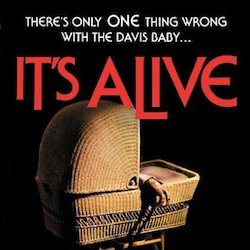
People might cite Rosemary’s Baby as the be-all and end-all of films about pre-natal anxiety, but think about it. Sure, she gave birth to the Antichrist, but she has a good support network right there in the building, and if she treats him right, she’s set for life. No, for my money Larry Cohen’s breakthrough monstrous infant hint trumps them all, beginning with one of the most unsettling ad campaigns of the Seventies.
Funny thing is, though it’s remembered as a film about a baby with fangs and claws who slaughters all the doctors in the delivery room before escaping to go on a killing spree around town, if you go look at it again now you realize that’s only a minor subplot. It’s also a conspiracy film about government scientists using unwitting citizens as guinea pigs. Above all else, though, it’s an indictment of the mass media, which has the power to destroy the lives and reputations of innocent people on a whim, in this case the Davis family. And damn but that John P. Ryan is great as the horrified and disbelieving father who finds himself and his wife being publicly blamed (as is So often the case) for giving birth to a kid who isn’t quite right.
Much smarter and more subtle than most would give it credit for, It’s Alive ! Is loaded with Frankenstein references, and went on to spawn two equally good (and very different) sequels. To this day I will not put my face or fingers anywhere near a baby’s mouth.
Devil Times Five (1974)
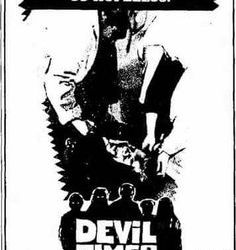
The early to mid Seventies were mighty good years for Leif Garret. Not only was his picture plastered all over every teeny-bopper magazine in the country month after month, he was also scoring supporting roles in huge drive-in hits like Macon County Line and Walking Tall. Let’s just say considering his squeaky-clean image, Devil Times Five (aka Peopletoys) was a departure.
Garret plays one of five kids traveling on a bus which crashes in the mountains during a snowstorm. With the driver dead and not knowing what else to do, the five youngsters take refuge in a nearby resort.
It eventually comes out the bus was actually delivering the kids to an institution for the criminally insane, as they’re all kookoo bananas and extremely violent. There were hints of this beforehand, as per the standard asylum movie cliche, each nutty kid has a telltale tic—this one thinks she’s a nun, the black kid thinks he’s in the military. etc. But it’s all just mild comic relief until they pick up the knives.
Well, before you can say “Mr. Green Jeans,” they begin slaughtering everyone at the resort in a variety of hilarious ways, and occasionally in slow motion.
Unlike other Killer Kid movies which try to explain away antisocial behavior by blaming it on assorted external forces (government scientists, radiation, aliens, Satan, or an eclipse), these kids are just plain old evil by nature, and that’s all there is to it.
It wasn’t a big hit, it didn’t do much to propel Garret into leading roles, but today it’s earned itself solid cult status as a pre-slasher grind house number. And what’s not to love about the ol’ “piranhas in the bathtub” gag?
The Omen (1976)
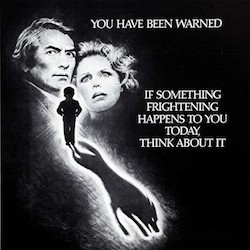
In the Seventies and Eighties, a number of once-huge stars—Ray Milland, Richard Widmark, Henry Fonda, Rory Calhoun, Ida Lupino, George C. Scott and, in this case Gregory Peck—found themselves making genre pictures simply because that was all that was available to them. Granted, The Omen was a few cuts above The Devil’s Rain and Tentacles, but still.
Okay, regardless what the producers and screenwriter David Seltzer may claim about the franchise’s origins, the original trilogy of Omen films was lifted wholesale from “The Devil’s Platform” episode of Kolchak: The Night Stalker.
Be that as it may, when you get a cast like this, a smart director like Richard Donner, a simply astonishing score by Jerry Goldsmith, some diabolical camera trickery and editing, wonderful practical effects (Lee Remick’s fall from the balcony kept me going for years), and a story about a smiling, (mostly cheerful 3-year-old Son of Satan wandering around England leaving a trail of beheadings, impaled priests, seriously pissed off baboons and hanged nannies in his wake, how can you go wrong? Even if the script itself is absurdly silly.
In an interesting postscript, like so many other child actors deeply associated with high-profile horror films of the era—think Danny Lloyd from The Shining—Harvey Stephens (who as Damien spoke, what, five words onscreen?) would not appear in another film for the next four decades. And even then he hasn’t been in much, though he did have a cameo as a reporter in the remake of, yes, The Omen a few years back.
Alice Sweet Alice (1976)
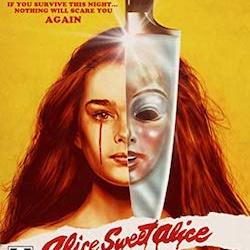
I dare you to show me one worthwhile horror film about Presbyterians. No, as far as religious sects go, Catholics have it all over everyone when it comes to horror. You got your robes, your chanting, your weird rituals, your transmutation, your Inquisition, your fetishism, your magic relics, your ghostly visions, oh, it just goes on and on. The Catholic Church is just one big horror show, top to bottom. As a result, Catholicism lay at the heart of countless horror films, and Alice, Sweet Alice is among the best.
The tagline read, “If you survive this night, nothing will ever scare you again,” which may or may not have been a reference to the fact this was Brooke Shields�� film debut. Shields plays 10-year—old Karen, the cute, quiet, polite and well-dressed younger sister of that moody, smart-mouthed and generally ornery Alice (Paula Sheppard), who likes to pull nasty pranks and doesn’t dress nearly as well as her sister. Everyone from the neighbors to their own parents to the local priest adores Karen and showers her with gifts, while they just wish Alice would go away. She clearly needs to see a shrink or something. So when Karen is brutally stabbed to death outside the church on the morning of her first communion and Alice is found with Karen’s veil in her pocket, well, there you go. And then when a whole bunch of other people around town somehow connected with Alice end up all stabbed to death as well, well, there you go again. I mean, she just looks like someone who could do something like that, right?
Alice, Sweet Alice is an American Giallo, so the less said about the story the better. For having such a tiny budget, the visuals are rich and gorgeous, filled with Catholic imagery and ritual throughout, featuring a cast of wholly unlikable characters you honestly don’t mind seeing stabbed to death (especially that Little Miss Perfect Karen). The one standout is Alphonso DeNoble as the crass, sleazy, filthy and morbidly obese landlord Mr. Alphonso. DeNoble has a terrifying charisma, which may have come from being a bouncer at a gay nightclub in Jersey in real life.
Yes, the film owes quite a bit, and blatantly so, to Roeg’s Don’t Look Now, but aimed at a more lowbrow mainstream audience. It’s a bloody, nasty little shocker still held dear by thousands of disaffected girls who survived Catholic school.
The Little Girl Who Lives Down the Lane (1976)
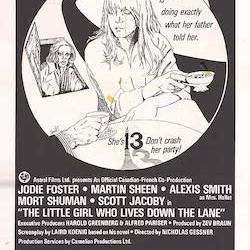
1976 was not only a busy year for Killer Kid films, it was also the busiest year of Jodie Foster’s career, during which she appeared in half a dozen films ranging from Taxi Driver to, well, this, a film she and other cast and crew members would bad mouth down the line. In retrospect, it’s not really as bad as all that.
A 13-year-old Foster plays 13-year-old Rynn Jacobs, a precocious girl who may or may not be living alone in a rented house in a secluded section of a small, affluent seaside town. Her rich, nosy and suspicious landlady keeps barging in uninvited to ask too many questions, the landlady’s perv of a son (Martin Sheen) keeps putting the moves on her, a local cop is endlessly curious but nice enough, and a gimpy teenage magician from the area knows the score. But Rynn is self-sufficient and smart beyond her years. Enough so anyway to dispatch with all those nosy yokels who’d try and pry into her business.
It’s less a horror film than an atmospheric mystery that ties up all the loose ends by the three-quarters mark. Based on a 1974 novel, the claustrophobic stagebound film is mostly forgotten today, but back in ’76 the poster creeped the hell out of me. Certainly more than the film did.
The Children (1980)
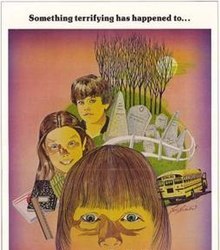
Although “creepy bloodthirsty children” seems to be a simple, straightforward notion just bursting with possible storylines, 1980 marked the point at which screenwriters and filmmakers everywhere seemed to run out of ideas, so simply began rehashing those earlier, better films. Case in point is this slight variation on Village of the Damned.
This time around, instead of mysterious alien impregnation, a school bus full of perfectly normal kids drives through a cloud of yellow radioactive fog released from a nearby nuclear power plant. The radiation, it seems, turns all the tykes into shambling, emotionless and murderous zombies. Instead of glowing eyes, the infected kids have black fingernails (which was easier on the fx budget), and instead of psychically driving adults to kill themselves, the mere touch of these evil zombie children can fry any adult to a crisp. With little else to do, the radioactive zombie kids lay siege to their small town as the adults try to figure out just how to handle this. I mean, it was already hard enough trying to get them to go to bed on time.
Oh, derivative as it is, the film does have it’s moments. In fact it includes one scene I must admit I’ve never seen repeated in any other Killer Kid film, in which a group of well-armed adults barricaded inside a house open fire on the army of evil radioactive curtain climbers massing in the front yard. And when the adults finally do figure out how to dispatch the little monsters, well, let’s just say it was unexpectedly gruesome.
The Godsend (1980)
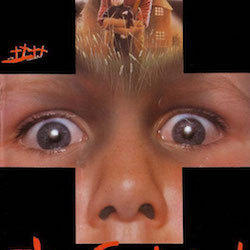
Given the year had already provided a Village of the Damned knockoff, it was apparently time for a Bad Seed knockoff, and an obvious one at that.
A pleasant and kindly British couple, the Marlowes (Malcolm Stoddard and Cyd Hayman) decide to take in a young unmarried pregnant woman even though they already have six kids of their own, telling her she can stay with them until she has the baby. What nice people those Marlowes are! But wouldn’t you know it? As soon as the ungrateful wench spits out the baby she vanishes without a word, leaving them with a seventh mouth to feed.
Being pleasant people they don’t complain too much, and over time the child grows into a polite and lovely little girl named Bonnie (Wilhelmina Green).
Well, sure enough before you know it all the other Marlowe kids start dropping like flies, and the parents take their own sweet time connecting the dots. I mean, come now people! We all know what happens to the youngest kid in a large family.
Itself based on a less-than-original novel, director Gabrielle Beaumont’s low-budget film plays like a TV movie, and lacks pretty much everything that made The Bad Seed so effective.
Bloody Birthday (1981)
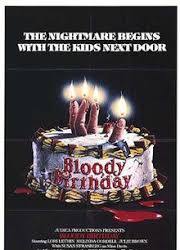
On June 9th, 1970, three women in a small California town give birth during a total solar eclipse (uh-oh!). The resulting three kids—Debbie (Elizabeth Hoy), Curtis (Billy Jacoby) and Steven (Andy Freeman)—understandably share a tight bond, and as their tenth birthday approaches in 1980, plans are underway for a big bash pretty much everyone in town is expected to attend.
In the week before the party, maybe just to trim that guest list down a bit, the trio of little scamps undertakes a killing spree. They bludgeon and strangle a couple of stereotypical slasher film teens making out in a graveyard, beat Debbie’s dad (the local sheriff) to death with a baseball bat, shoot a teacher, and attempt to lock a classmate in a refrigerator in a junkyard. No one suspects them, of course, because they’re freaking nine years old. Nowadays we know better. While you’d expect the big party to be the film’s climactic scene, it just comes and goes without much happening, and those darn kids keep killing.
Around the halfway point, a teenaged amateur astrologer offers up the closest thing we get to an explanation for such naughty behavior. During that eclipse, see, both the sun and moon were blocking Saturn. Since Saturn controls the emotions, these kids were born with no conscience. Okay, so you come to accept a lot on faith in these things. Ultimately, though there are hits of both Village of the Damned and Bad Seed here, the picture owes much more to Devil Times Five.
Director Ed Hunt had made a handful of genre cheapies prior to this, but today Bloody Birthday remains his most memorable film. The dialogue is often painful, the soundtrack is comprised of library music from TV movies, and it’s not nearly as gory as would become standard for slasher films, but his three little killers all exude a believable David Berkowitz vibe, and the film contains enough boobs to earn an R rating. In an irrelevant sidenote, it remains one of the very few entries here in which the kids use guns, and, I think, the only one in which they use a bow and arrow.
Sleepaway Camp (1983)
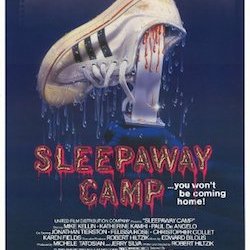
Writer/director Robert Hiltzik’s weirdie is a delightfully oddball number not only within the Killer Kid subgenre, but also among slasher films, which is doubly surprising considering when it was released.
Although the film at the outset has all the standard earmarks of a cookie-cutter post-friday the 13th slasher film (a bunch of youngsters at summer camp, and endless supply of sharp implements, a fast-rising body count), careful viewers will note a few unsettling details. First, apart from the counselors, most of the campers (and victims) are pre-adolescent, and all the males, young and old alike, wear shorts that are just a little too short and a little too snug. Hmm.
Anyway, Angela (Felissa Rose), has been sent to summer camp against her will with her older brother. She’s pretty and nice and shy, but has clearly been damaged in some way. She adamantly refuses to go swimming or play games ore shower wit the other kids, despite repeated (and usually understanding) pleas from the counselors. She prefers to be alone, and isn’t much interested in making new friends. I know the feeling. I was sent to summer camp once, and after a lummox named Trent got to go home because he got a fish hook in the eye, I considered bribing those kids with the fishing poles to do the same to me.
Anyway, if you haven’t seen it, the less said the better. Let’s just say it fits the category, but with a notorious twist, and remains near the top of the lists of many slasher film fanatics I know. I do wonder, though, given the age we’re living in, how this one would go over today. It also leaves me wondering what the deal is with that Robert Hiltzik.
Children of the Corn (1984)
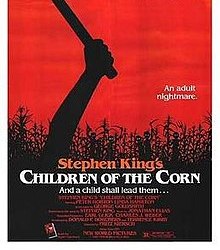
Yes, it’s a stinker, but remains a memorable touchstone within the then exploding subgenre of Stephen King stinkers. I always find it funny that King continues to bitch about Kubrick’s adaptation of The Shining, but never has a word to say about this, or The Mangler, or Silver Bullet, or Maximum Overdrive or…
But that’s beside the point. Given the subject at hand, both the original short story and Fritz Kiersch’s film adaptation are interesting in that they represent a genre-blending crossover between Killer Kid movies and Religious Zealot horror.
AS much as there is to chuckle at here—my goodness what an awful bit of filmmaking, from the script to the performances to the camera set-ups and fx—dammit I keep going back to it. I do enjoy that flashback in the diner, as well as the fact the initial slaughter of the adults is never clearly explained. Not really, anyway. And I do dig the amateurish overacting on the part of John Franklin as the crazy young preacher Isaac and Courtney Gains as his True Believer henchman Malachai. And I’ll watch that R.G. Armstrong in anything. Mostly, though, I think I keep going back time and again just to hear the line “He wants you, too…Malachai!,” which has been a catchphrase of mine for years now.
Firestarter (1984)
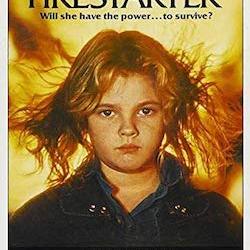
Amid the mid-‘80s flood of Stephen King quickies, at least director Mark L. Lester had a few more chops than most. He also had a much larger budget, which allowed him to sign a cast that included George C. Scott, Art Carney, Louise Fletcher, Martin Sheen and Heather Locklear (!).
So a young couple who met in college while volunteering as research guinea pigs in a secret government drug test later get married and have a daughter. As these things happen (see Blue Sunshine or Jacob’s Ladder), those secret government drug tests have a way of hanging around awhile, with some mighty unexpected side effects. In this case, their new daughter Charlie (Drew Barrymore, who was in a few King adaptations) was born with pyrokinetic powers, meaning she can set anyone or anything she doesn’t like ablaze, the lucky brat.
Well, a few years later when the secret government agency that ran the secret government drug test catches wind of what little Charlie can do, they decide they’d like to have a little chat with her, and maybe her dad too (the briefly popular David Keith), who himself might have psychic powers. Or maybe they’d like to have something more than a chat.
Less a horror movie than conspiracy thriller and chase picture, Firestarter remains an oddity here, as it’s one of the few Killer Kid films in which we’re asked to root for the Killer Kid, actually hoping the wee pyro in question, even though she’s cute and blond, will set a few of those icky, mean adults on fire.
It’s hardly on a par with The Shining, Carrie, or The Dead Zone, but at least it’s better than Night Shift, Sometimes They Come Back, Children of the Corn IV, Cat’s Eye, Maximum Overdrive…
The Omen IV: The Awakening (1991)
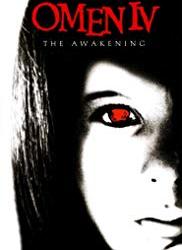
As would become standard for plenty of other franchises that had seemingly run their course, some bright TV executives thought there was still some money to be made with that whole Omen thing. A decade after the last and supposedly final entry came out, why not give it the TV movie treatment? And while we’re at it, why not give it a fresh twist by doing a little gender switcheroo, right? So this time around, why not make Damien a girl? That’d throw viewers for a loop, wouldn’t it?
(An Omen IV novel had actually been released shortly after The Final Conflict came out, but it had nothing to do with this.)
The events of the previous three films have long been forgotten by the time we get underway here, I mean, don’t we see the Second Coming of Christ at the end of Final Conflict? Okay, so I guess Jesus had gone on vacation or something by the time two young smug and wealthy lawyers (Michael Woods and Faye Grant) adopt a new daughter without asking too many questions.
Their daughter Delia (Asia Vieira) grows into a pretty, dark-haired young girl who is extremely unpleasant. Oooon, but she’s a bratty little smartass who could use a spanking. I always thought the Antichrist was supposed to be charming and charismatic, but I’ll let it slide. In any case her New Age hippie nanny starts to suspect something far more sinister than smug parents might be at the heart of Delia’s bad attitude. When all her magic crystals turn black in the little girl’s presence, she starts making frantic calls to her other New Agey friends.
I’m going to stop there. Hilariously awful film, save for one scene, And that one scene alone is reason enough to forgive the film’s countless other unforgivable flaws.
The nanny drags Delia to a New Age fair in a park in hopes of getting a snapshot of her aura, and let’s just say things don’t go well for much of anyone. In simple slapstick terms, it’s on a par with Final Conflict’s montage of baby murders.
The Good Son (1993)

As he transitioned from the “dorky, buggy-eyed but still weirdly cute” kid in the Home Alone pictures into a “dorky, buggy-eyed and much less cute” adolescent, Macaulay Culkin decided to prove his range as an actor by playing against type in still another take on The Bad Seed.
Instead of telling the story through the mother’s eyes, in Joseph Ruben’s film we see things through the eyes of a nice, wholesome kid named Mark (a young Elijah Wood). After his mother dies, he’s sent to live with an aunt and uncle and two cousins. Not yet knowing he should avoid anyone named “Henry,” Mark and his cousin Henry (Culkin) become good friends. But after Henry is clearly delighted when one of his silly boyhood pranks triggers a deadly multi-car pileup, and after he shows off his homemade gun to Mark, and furthermore hints he once tried to kill his own brother, Mark starts to get the idea Henry might well be a psychopath with bigger diabolical schemes in mind.
Ruben’s picture is a slight cut above the likes of, say, The Godsend thanks to that change in perspective. Although Culkin makes for a believable psycho kid, it didn’t really do much to revamp his career and set him on that road to an Oscar. Thinking about it, though, Henry’s use of improvised and homemade weaponry wasn’t that big a step away from his Home Alone character, but with more fatalities and fewer cartoon sound effects..
Home Movie (2008)
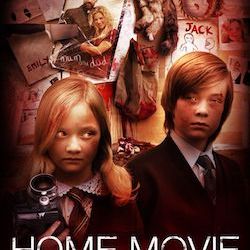
The found footage/hand held video/POV horror film was pretty well dead and buried as a style by 2008, but that sure didn’t stop anyone. It was a cheap way to make a movie, after all. In this case, though, the story would have worked much better as a straight narrative, as the POV gimmick just gets in the way, leaving viewers (or maybe just me) repeatedly asking, “Why would anyone be filming this?”
Why, for instance, would an alcoholic Lutheran minister (Adrian Pasdar) choose to film an intimate argument with his psychiatrist wife (Cady McClain)? And why would a psychiatrist use the family video camera to record private patient notes, leaving them mixed in there with the Christmas and Easter home movies? Maybe writer/director Christopher Denham was trying to make a point about people so obsessed with living through screens that they can easily ignore the obvious and increasing threat posed by their clearly disturbed twin children, who mostly just lurk in the background as the parents focus on themselves. I doubt it though.
The creepy ten-year-olds Jack (Austin Williams) and Emily (Amber Joy Williams) were born on Halloween. While their parents try to desperately prove just how fun and cool and hip they are by setting up haunted houses in the basement and teaching their kids how to pick locks, Jack and Emily spend the first half of the film staring sullenly at the floor. Soon enough though, they begin killing goldfish, crushing toads in vices, crucifying the family cat, and attacking schoolmates, working their way up the evolutionary chain toward You Know Who.
Oh, I’m not giving a goddamn thing away here—the goddamn tagline gave it away! And even without the tagline if you couldn’t see exactly where this was headed with the first scene, maybe you need a nap or something.
To it’s credit, like Devil Times Five, Home Movie offers no explanation for why the kids are funny in the head. If you wanted to push it you could make something out of that Halloween birthday or the fact the family name is “Poe.” Myself, I just tend to accept that any kid unlucky enough to have a preacher or a shrink as a parent is fucked from the start.
Case 39 (2009)
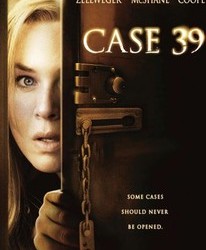
Renee Zelwegger stars as a young sincere and overworked case worker at Children and Family Services. After the seemingly unbalanced parents of a shy, sweet and neglected girl on her case list try to cram the pre-adolescent into the oven (repeatedly!) one night, the parents are institutionalized and the social worker adopts the girl.
Okay, same as with Home Movie, if you can’t see where this one was headed ten minutes in, theres something wrong with you. Funny twist is, while I initially took it to be simply yet another Bad Seed knockoff (which it is) before deciding it was simply another Omen knockoff (which it is), by the half way point it finally became clear: what I was watching was in fact a knockoff of Omen IV: The Awakening. And that’s pretty bad. To make it all even sadder and more pointless, Case 39 is capped by a climax that makes absolutely no sense, if you think about it even for a little bit. Even the Omen IV had a better ending, and that’s saying something.
Considering all the above, the ultimate lesson to take away here is that, talk as we might about The Terrible Twos, it’s when the little monsters turn ten that you really need to watch out.
by Jim Knipfel
5 notes
·
View notes
Note
So you go on an entire rant about how you don't like Valka (granted alot of your reasons make sense.) But then you go around liking Octavian!?!?!? And call him Tavy and give him a redemption arc!? Luke I understand but seriously Octavian!? See that right there is grounds for divorce.
*rubs temples slowly*
Okay. So. Apparently I’m actually answering that. Who knew.
Did you actually read the rant about Valka? About how pointless, useless and badly retconned in she was? How her presence in the movie made the universe less coherent?
Because those are all things that do not apply to Octavian.
Also. Stop it with your Greek perception of things.
Like, seriously. I think that is the biggest problem. Everyone is against Octavian and hating on him because everyone still has the mainly Greek-goggles on.
So, for the following, I would love for you to take those off and try perceiving things from a Roman standpoint. Because I wildly agree with most of Octavian’s actions based on his knowledge at the time and his experiences as a Roman. Sure, he took an asshole-approach to things, but fundamentally speaking, he was in the right.
Greeks did not know about Romans.
But Romans knew about Greeks. Romans were taught about the fact that the American Civil War was caused by a Graeco-Roman rift. Romans are raised on the fundamental “truth” that Greeks are the enemy and that they are primitive.
(Which. The latter, I think, we can all agree on. Romans have an entire city and ecosystem, have ranks and politics. Greeks have an overcrowded summer-camp that was so badly organized that it literally caused the Titan War.)
Okay, so. You’re a Roman. You were raised always being taught that Greeks are evil, Greeks are dangerous, Greeks are primitive. That does, by no means, make those statements true, but it warps your perception. You grow up, believing those things, believing that the war your ancestors fought against Greeks was just and that Greeks are the enemy.
The leader of your home, one of your protectors, goes missing for six months, leaving you rather defenseless.
In that time, a stranger (Nico) starts visiting regularly.
Another stranger, without memories, comes to your home and is presented to you as a Roman and you elect him as your leader.
It is then revealed to you that your newly chosen leader is actually the enemy. That is, basically, like y’all electing a Russian sleeper into the White House (which, at this point, doesn’t really sound very far-fetched considering certain interviews but let’s not go there).
Furthermore, it is revealed that the stranger who regularly visited is also a Greek. Basically, a spy who kept tabs on you.
Lastly, it is revealed to you that your leader who has been gone for half a year, was actually with the Greeks. With the enemy. For six months. Was he brainwashed? Because he behaves oddly now. Was he kept against his will? After all, he didn’t call or come back for half a year. There is no way you could tell that you can actually trust Jason Grace at this point, because the enemy might have turned him.
Oh, by the way, the stranger who has been spying on you for six months? Yeah, he knew the whole time where your abducted leader was and never mentioned that either. Funny, right?
Then the fact that the Greeks did not just drop by for a visit. They seriously thought it was a great idea to fly over in a warship. Which, in itself, pretty much a declaration of war already because my neighbor kind of never comes over for tea in a tank, you know?
The crown-jewel of it all? One of those Greeks, after the Romans showed good faith and invited them in, shot their city point-blank with said warship.
And I swear, if anyone brings the “Leo was possessed by ghosts” argument - please, read that aloud, mull it over for a second and hear how ridiculous that sounds. An act that can only be described as a terrorist attack but “the ghosts made him do it”. Even though you have been weary from the start because Greeks are the enemy and they somehow had your leader for six months and now come knocking at your door with a warship.
There was absolutely no reason for a single Roman to trust anything the Greeks said after the point of attack. It was literally, fundamentally, ridiculous that Reyna, Frank and Hazel got on board with this bat-shit crazy stuff. Based on what exactly? One short adventure with Percy, who previously was a total stranger?
I swear, Reynabeth is the only logical reason for me to understand why Reyna would trust them after one short conversation with Annabeth.
So.
Let’s recap where the Romans are at that very point.
The race of people you had always been warned about and taught not to trust just invaded your home with a warship and burned down part of your city. They also apparently brainwashed your leader. And possibly kidnapped two other Romans - at that point, it was hard to tell if Frank and Hazel had gone with them willingly or if they had been abducted as hostages.
To go after them with the intention of war is the only logical conclusion.
And then, it turns out, that blonde Greek witch managed to warp the mind of your second leader, because Reyna “turns her back” on her people. She decides, out of very thin proof, to trust the Greeks.
You are now officially without a leader. You are now in the middle of a battle.
And you are Octavian.
You’re the closest thing the Romans have to a leader right now, with one a possible double agent and the other having betrayed you to follow the enemy. Your home is burned, there is a battle. You are Roman, a race of pride and war. You will not accept this. You go after them in retalliation. You find their home to pay them back for what they did to yours.
I’m sorry, but I do not accept the antagonizing of Octavian’s actions, because from the standpoint of a Roman who has been raised with Roman values, holy shit how could he have done anything differently?
Not to mention that he as a legacy has been raised with Roman believes his whole life. Reyna? She only joined New Rome three years ago. She has only been taught the history and values of Romans when she was 14. That is a wildly different perception than someone who has been raised in a community and with said community’s history from the day they were born.
Sure, Riordan made sure to give him a corrupted, selfish motivation of always having wanted to become the leader too. And sure, you can argue that what he did, he did to achieve his own goal. And in the end, if you look at all the facts, Greek and Roman alike, he was in the wrong - but at the time? There was virtually no way of telling and there sure were no reasons for him to believe that he was wrong. There was no reason for any Roman to believe they were wrong.
So. Yeah. That’s why I like Octavian.
He is the only Roman to act logical and not just according to script. All others have this stupidly blind trust that is so vastly unrealistic. It’s, quite frankly, really very dumb that Reyna, Frank and Hazel - though Hazel maybe solemnly based on Nico being her brother - to side with the Greeks.
I like that he acted in a realistic way, considering the things we have learned about how Romans are, what they believe in, how they act. I also like that he’s a selfish prick, because for fuck’s sake not everyone is a gentle, loving, open-minded sweetheart, urgh. The sequels were so busy making everyone so flawless and nice and understanding and it drove me crazy.
Octavian acted logical and with an understandable - albeit selfish - motivation behind. The “good” Romans? Quite frankly, they lack a relatable motivation in my eyes.
But of course, everyone of importance had to trust the Greeks and hug it out because otherwise Riordan would have had a plot-problem.
#octavian#heroes of olympus#yes i like him#purplesparklyinkpad#pjoverse#Percy Jackson and the Olympians#Heroes of Olympus
70 notes
·
View notes